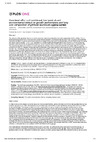Please use this identifier to cite or link to this item:
https://accedacris.ulpgc.es/jspui/handle/10553/59923
| Title: | Combined effects of nutritional, biochemical and environmental stimuli on growth performance and fatty acid composition of gilthead sea bream (Sparus aurata) | Authors: | Torno, Claudia Staats, Stefanie Fickler, Anna de Pascual-Teresa, Sonia Izquierdo, Marisol S. Rimbach, Gerald Schulz, Carsten |
UNESCO Clasification: | 310502 Piscicultura | Keywords: | Bass Dicentrarchus-Labrax Acyl Delta-6 Desaturase Dietary Fish-Oil Rainbow-Trout Lipid-Metabolism, et al |
Issue Date: | 2019 | Journal: | PLoS ONE | Abstract: | The reliance of the aquafeed industry on marine resources has to be reduced by innovative approaches in fish nutrition. Thus, a three-factorial approach (fish oil reduced diet, phytochemical genistein, and temperature reduction) was chosen to investigate the interaction of effects on growth performance and tissue omega-3 long chain polyunsaturated fatty acid (LC-PUFA) levels in juvenile sea bream (Sparus aurata, 12.5 +/- 2.2 g). Genistein is a phytoestrogen with estrogen-like activity and thus LC-PUFA increasing potential. A decrease in the rearing temperature was chosen based on the positive effects of low temperature on fish lipid quality. The experimental diets were reduced in marine ingredients and had a fish oil content of either 6% dry matter (DM; F6: positive control) or 2% DM (F2: negative control) and were administered in the plain variant or with inclusion of 0.15% DM genistein (F6 + G and F2 + G). The feeding trial was performed simultaneously at 23 degrees C and 19 degrees C. The results indicated that solely temperature had a significant effect on growth performance and whole body nutrient composition of sea bream. Nevertheless, the interaction of all three factors significantly affected the fatty acid compositions of liver and fillet tissue. Most importantly, they led to a significant increase by 4.3% of fillet LC-PUFA content in sea bream fed with the diet F6 + G in comparison to control fish fed diet F6, when both groups were held at 19 degrees C. It is hypothesized that genistein can act via estrogen-like as well as other mechanisms and that the dietary LC-PUFA content may impact its mode of action. Temperature most likely exhibited its effects indirectly via altered growth rates and metabolism. Although effects of all three factors and of genistein in particular were only marginal, they highlight a possibility to utilize the genetic capacity of sea bream to improve tissue lipid quality. | URI: | https://accedacris.ulpgc.es/handle/10553/59923 | ISSN: | 1932-6203 | DOI: | 10.1371/journal.pone.0216611 | Source: | Plos One [ISSN 1932-6203], v. 14 (5) |
| Appears in Collections: | Artículos |
Items in accedaCRIS are protected by copyright, with all rights reserved, unless otherwise indicated.
